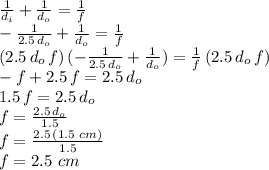
Physics, 12.08.2020 20:01 mrashrafkotkaat
A small insect viewed through a convex lens is 1.5 cmcm from the lens and appears 2.5 times larger than its actual size. Part A What is the focal length of the lens

Answers: 2


Other questions on the subject: Physics

Physics, 21.06.2019 22:20, kl8774
Aboxcar traveling at 12 m/s approaches a string of 5 identical boxcars sitting stationary on the track. the moving boxcar collides and links with the stationary cars and they all move off together along the track. what is the final speed of the cars immediately after the collision? (you may take the mass of each boxcar to be 18,537 kg.)
Answers: 1

Physics, 22.06.2019 02:00, arinegrete2003
What is created when solids, liquids, an gases mix with one another
Answers: 1

Physics, 22.06.2019 03:00, bwheele6791
Arotating space station is said to create “artificial gravity”—a loosely-defined term used for an acceleration that would be crudely similar to gravity. the outer wall of the rotating space station would become a floor for the astronauts, and centripetal acceleration supplied by the floor would allow astronauts to exercise and maintain muscle and bone strength more naturally than in non-rotating space environments. if the space station is 200 m in diameter, what angular velocity would produce an “artificial gravity” of 9.80 m/s^{2} 2 at the rim?
Answers: 3

Physics, 22.06.2019 12:30, fernandoluvsmom
What would be the strength of earth's gravitational field at a point where an 80.0 kg astronaut would experience a 80% reduction in weight
Answers: 3
You know the right answer?
A small insect viewed through a convex lens is 1.5 cmcm from the lens and appears 2.5 times larger t...
Questions in other subjects:

Mathematics, 28.09.2020 18:01



Mathematics, 28.09.2020 18:01




Mathematics, 28.09.2020 18:01

Mathematics, 28.09.2020 18:01

Mathematics, 28.09.2020 18:01

 , of image
, of image  , and focal length;
, and focal length;




